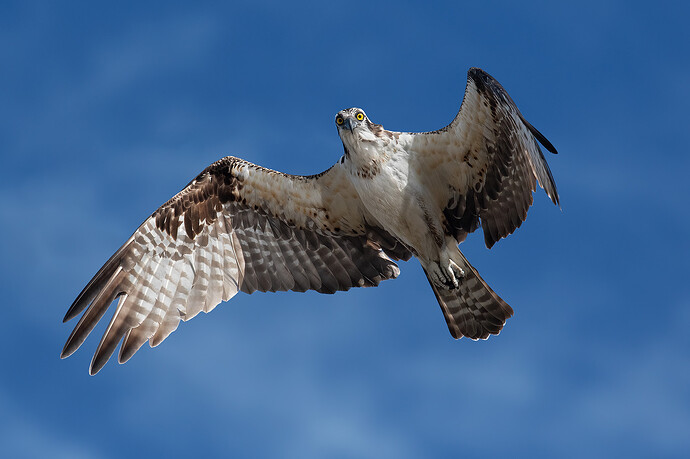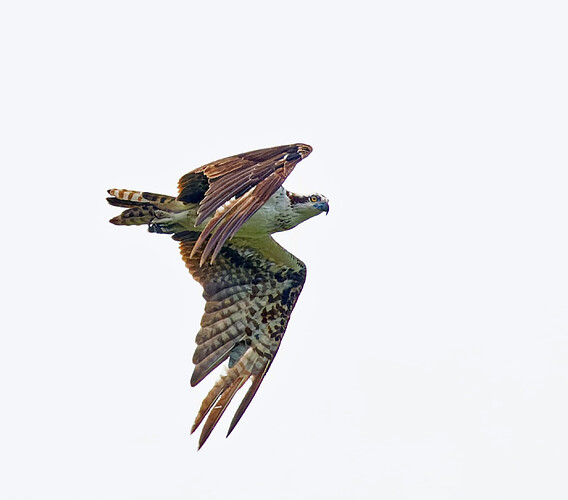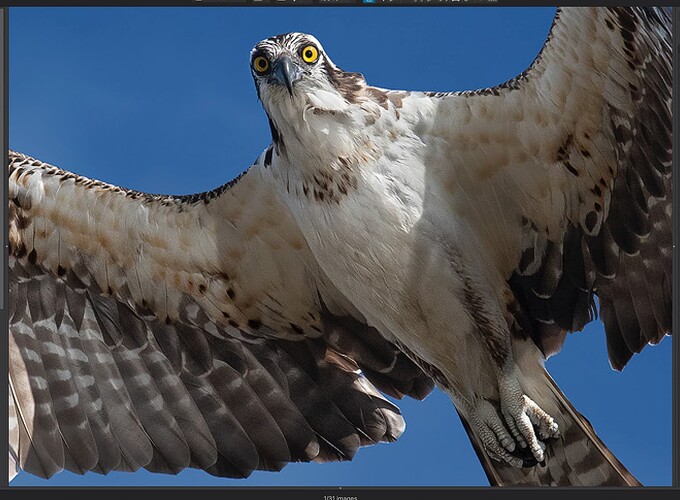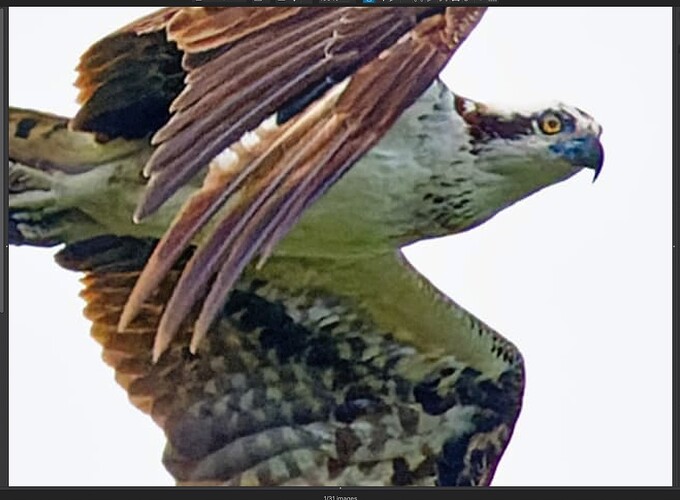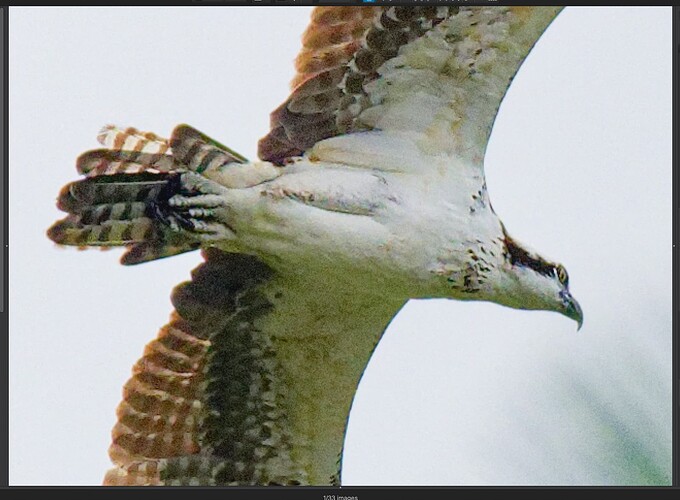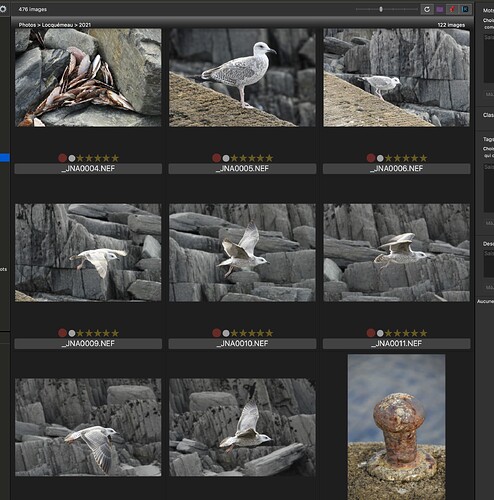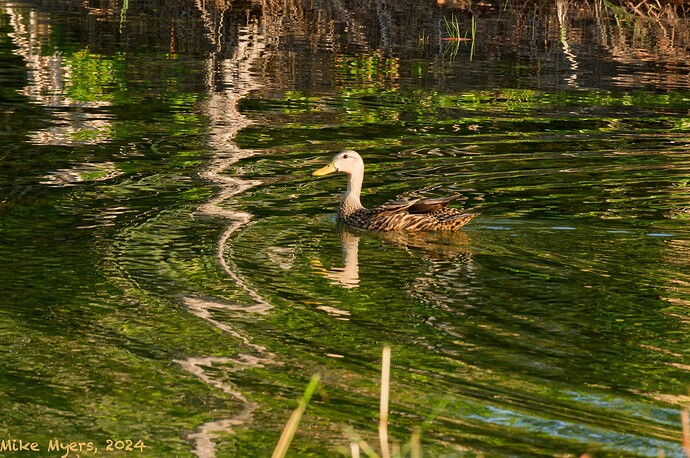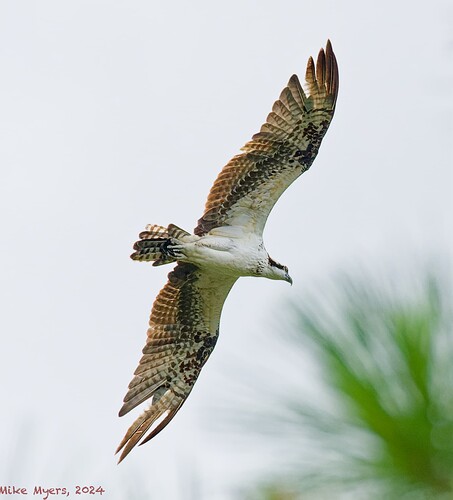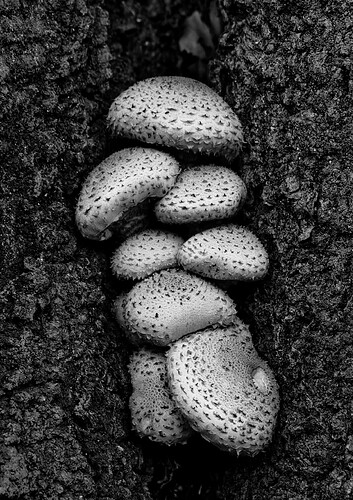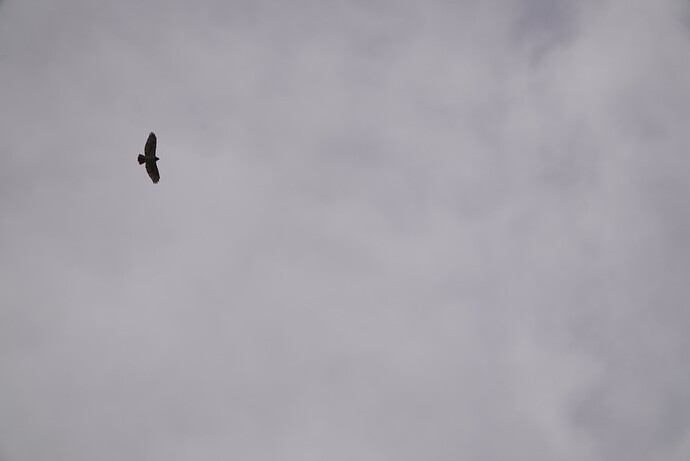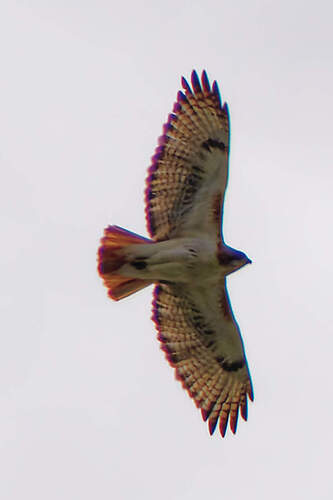True, but if so, why isn’t the eye brighter? I dunno. It looks more like a shadow to me, because of the eye. @Joanna will know one way or another.
If you are satisfied, why are you asking how to improve it?
Try taking a look at the galleries on your newly found Backcountry Gallery Photography Forums site.
Then to compare, here is one of Steve Perry’s images of an Osprey…
… compared to yours…
The most obvious difference visually is that he shot against an interesting blue sky, which instantly gives it more “life” instead of a blank white background.
Then look at the difference between a screenshot of his image at 400%…
… and a screenshot of your image at 400%…
Notice anything? Like feathers and detail in his image which are simply not present in yours.
Steve took his on a D500 with only an APS-C sensor of 20Mpx but one major difference is that he used a prime 300mm f/4 lens, which is bound to give sharper results than a zoom. Not forgetting that, with an APS-C sensor, he is using the equivalent of a 450mm f/4.8 prime lens, due to the 1.5x crop factor of the sensor.
My guess is that one major difference is that Steve chose the “decisive moment” to press the shutter, when everything was right, including the bird being close enough to fill the frame better.
Then you have to consider the D500 pixel density for the APS-C sensor is actually the equivalent in full frame of my D850 at around 46Mpx.
My takeaway from that video is that it really isn’t worth your while moving to mirrorless. And please remember your camera is not mirrorless - it simply uses the same autofocus technology as a Z series that happens to be mirrorless. A camera is only truly mirrorless when you can use the EVF, otherwise, using the back screen in live view is just the same as using any other DSLR with a back screen.
Not much. Look at this 400% zoom screenshot and compare it with Steve’s…
See that same lack of detail?
But I did hardly anything. What you see is a screenshot of an uncropped 6Mpx image, taken with a D100.
It’s a Patagonian Crested Duck (Lophonetta specularioides specularioides) from Southern Chile, Southern Argentina & Falkland Islands and, I’m sorry but that is what the bird looks like.
This from the “journalist” who didn’t dare retouch an image! It is a record shot of the bird, as it appeared in its local environment, which includes reflections of surrounding trees.
But, as I have said more than once, this is the original image, taken with the framing that I wanted to capture the detail of the bird. Things like waves are secondary, unavoidable factors, caused by the fact that the duck was swimming in water, which creates a bow wave. It is a factual shot of a factual duck.
Thank you Stuck for that injection of sanity ![]()
Because it is a factual image of a factual duck. That is how it appeared in the prevailing lighting conditions. If you don’t like what it looks like, I suggest you talk to the duck.
More likely this is the best shot from a burst mode sequence of N pictures, where N is a large number. In my limited experience that’s how most birders get this sort of shot.
You may well be right. Here is the sequence I took to get one shot of the seagull in flight…
Personally, I tend to press the shutter repeatedly rather than use burst mode - to me, it saves deleting so many after the fact ![]()
For @mikemyers , these were shot with my D810, with the 28-300 at 170mm. ISO 4000, 1/640s @ f/10. The screenshot was taken from my keywording app, so all thumbnails are totally unprocessed RAW files
Deleting is the easy part. I hate the selecting before ![]() But while a seagull at taking off is rather slow and easy to track, swallows or kingfishers in their normal speed are impossible to catch at decisive moment. While the mirror of your DSLR is already busy moving up, the moment is gone to the next bar, ordering a few beverages. Cheers
But while a seagull at taking off is rather slow and easy to track, swallows or kingfishers in their normal speed are impossible to catch at decisive moment. While the mirror of your DSLR is already busy moving up, the moment is gone to the next bar, ordering a few beverages. Cheers ![]()
For you to compare me to Steve Perry is silly.
https://www.youtube.com/@backcountrygallery
But I certainly appreciate all the articles and videos he has created to help others to come closer to his ability. He has likely captured thousands of photos of Osprey, compared to my single burst of 20 or so exposures. He has the luxury of choosing from those multi-thousands of likely images, at different times and places. That my one opportunity was on a cloudy day with a “white” background is irrelevant, but if I didn’t hate the concept so much, I could easily replace the sky. That his huge lens captured more detail than my “tiny” 300mm lens, not to mention he is so experienced at this, implies my photos can never compete against his. On the other hand, I haven’t yet seen anyone in our forum post a better image of an Osprey in flight, or any other bird for that matter. I’m lucky to even be able to spell Osprey correctly - I knew/know nothing about them.
The most relevant question I am now considering is whether to even bother to spend the money for a 500 or 600mm lens, $1,000 if I buy the Nikon 200-500 new, a few hundred less if I buy one used. I may never see another Osprey again for the rest of my life.
Other things I’ve learned here - for birds, leave my camera in high speed burst mode just in case I need it. Instead of 20 shots to consider, I might have captured 200 images one of which might have been better.
Somewhat sorry about what I wrote about your “Patagonian Crested Duck”. Never heard of it before, and being used to domestic ducks, I assumed it was in shadow. @stuck knew the real situation. I don’t like that photo, for several reasons, but if the dark areas are natural, so be it.
I doubt the duck had any control over this, any more than we humans have control over our body colors. Maybe if the duck was out in the open, I’d have realized this, but the photo led me to the wrong conclusion (my fault, as @stuck realized this correctly. Regardless, I now realize I was wrong).
Point learned. From now on, I will leave my camera in burst mode unless I turn it off for shots where it’s not needed.
That’s what I used to think, but based on this discussion I’ve changed my mind.
With the D780, in the proper mode, the mirror stays “up”. Since the viewfinder needs to be able to also work as a DSLR, until/unless Nikon provides a second viewfinder for mirrorless, that’s a limitation. The technology of the Z6 is there, but not the ability to see it through the viewfinder. I have yet to try this. I asked about it in Steve’s forum, but haven’t had an opportunity yet to test it:
Back to the original discussion. If I buy a lens like what Steve Perry uses, my camera gear should be capable of capturing photos like Steve’s, leaving me as the weak factor in all of this. Steve has been doing this for years, probably decades. For me, weeks. I doubt I will ever be able to capture images like Steve’s images, but the technical aspects are something that $$$ should resolve. Or, I just need to concentrate on birds that are closer to me and my 300mm lens.
So tempting, for $1000:
Thanks for posting this - I sort of understood, but learned a lot more that I wasn’t aware of. Another reason to leave high-speed-burst-mode active for birding…
I had hoped you were joking but now I’m not so sure. That’s not a shadow, that’s the color of the bird’s feathers. It doesn’t look even remotely like a shadow.
I am 77 and probably a few years younger than you. I had cataract surgery a couple of years ago and it improved my vision significantly, especially with regard to the removal of cataract color cast and an improvement seeing distant fine detail. I no longer use glasses for distance viewing.
It occurred to me that perhaps you may need to consider similar eye surgery at your age If you haven’t already done so. The idea that you thought the feathers on the top of the duck’s head might be shadow and your current happiness with heavily cropped very low resolution images, lacking fine detail, seems like a red flag to me.
Of course, the issue you are having with the duck might be something else. Based on various previous discussions regarding abstracts it is clear that all images need to be grounded to a visual reality that you understand. Most recently @Joanna’s image of a cider barrel plug hole confused you because you couldn’t identify was even though it was presented as part of a series.
Seeing a duck that you are unfamiliar with may have confused those perceptions similarly giving you the impression it was a shadow.
Mark
“so all thumbnails are totally unprocessed RAW files”
Are you sure?
To display these RAW files, the application has either to convert them in something that can be displayed or to use the embedded JPG. Both are processed, not by you, but by the application or the in camera firmware.
Well, I already had my cataract surgery, and another surgery. I have “diplopia” as my eyes don’t work together as most people’s eyes. It’s like stereo vision, where each eye sees the world differently. Every time I go to the eye hospital I volunteer at, I get my eyes checked. I can’t judge distance, or whether something (baseball??) is coming towards me. My reaction time is also rather slow. As for @Joanna’s duck, I obviously jumped at the incorrect conclusion, but I’ve never seen a duck with a dark head like this. Obviously, I was wrong, in retrospect.
As for ducks, I’ve just spent a week photographing ducks, none of which had a dark area on the top of the head. The most logical explanation to me was that her duck was in a shadow area - obviously not, but I’ve never seen a duck like this before. You’re correct - it doesn’t really look like a shadow, but even the eye was darker than I expected. I think this was an ugly photograph of a very strange duck. I love photos like the duck photos I already posted up above. It shows my duck, the surroundings, and lovely looking “waves” which created bizarre patterns. I tried to remove the “stuff” at the bottom, but didn’t like the end result.
To me, based on my life so far, much of which was “journalism” photos, a pixelated or blurry image is better than no image, and most people who view my pixelated image of a far-off bird enjoy them. Me too, but I want to do better. Is it worth spending $1,000 - - - maybe not.
Back to what you wrote, I have Essilor progressive lenses, so I can see close-up, distant, and anything in-between, just by looking through the appropriate part of the lenses. I’ve done this so long, I’m used to it. For me, better than carrying multiple sets of eyeglasses.
To me, photographing things that are too far away, leading to an unsharp image, is preferable than no image at all. It’s also good practice for when I buy a better lens for that purpose. Just following a bird has already been a challenge, and I’m better at it than before - but nobody will know this until when/if I get a more appropriate lens.
Joanna’s link, and the video posted up above, leave me more anxious than ever to follow through on those ideas. Maybe BIF is beyond my capabilities (Birds In Flight).
You might be spot-on about my vision - my reaction time is longer than it used to be. Cameras and Lenses now feel heavier than they used to. Even this $1000 lens might be heavier than I can deal with, even on a monopod…
And after the first eye and viewing a white paper that paper was white with one eye and yellow with the other.
George
It has always been my understanding that a raw file contains a small jpg image, which is what we see when we review the image on our cameras. I think this is what the thumbnails show us.
Very old memory…
Or, to be more precise, they are the JPEG preview images of the the unprocessed RAW files, thus showing what you would see before processing.
Actually, if you could find a cheap secondhand D500 APS-C camera body, that would be ideal for extending any of your lenses for a lot less cost than yet another long lens, which will mostly duplicate those you already have. You should be able to pick one up for less than $1000 and you would have 1.5 times the focal length of all your existing lenses.
But he doesn’t have a “huge lens”. He has a 300mm, just like you. The difference is that he uses an APS-C sensor camera that effectively gives him 450mm with that same 300mm lens.
There may be some circumstances when an unsharp and low detail image is preferable to no image. From my perspective images lacking sharpness and fine detail as a result of distance, extreme cropping, low resolution, poor technique, low quality lenses, or any other reason are only keepers if the subject is unique, important, or not reproducable. Your photo of those gathered boats would be an example of a poorly captured keeper If as you suggested It’s intent was to identify an illegal violation of the law.
None of you other low resolution images meet any of those criteria except pethap as learning examples for yourself to help you understand the issues and develop new skills and/or learn how to avoid the limitations.
The fact that some of your friends think those low resolution images good are either just being kind or have very little understanding of photography and what makes a good photograph.
Mark
Wrong. The lens will always remain 300 mm FL for FF, the sensor is just a pre-crop, therefore it has the same effect as a 300 mm on your D850. It‘s cropping before post-processing.
I was reading the replies in the other forum I noted earlier:
Is this photo any good? | Backcountry Gallery Photography Forums
The opinion in the other forum is that the practice I get in doing bird photography is far more important than any images I start to capture. More money spent for better gear will likely help create more detailed images, but just learning how to capture the images is much more important. I was trying to explain that here, but I did a lousy job.
I won’t be posting bird photographs here until/unless I am satisfied with them, but it may take years, if not decades, for me to capture images as good as @Joanna’s examples, if ever. For that, I obviously need better lenses, but I need to learn how to capture the images properly. My “duck hunting” was much more enjoyable from beginning to end, and most of the time, 300mm was all I needed, and I was pleased with the results.
Perhaps, or perhaps they are not yet as skilled as the better photographers in the forum. The purpose of that forum is mostly to teach others how to do good bird photography. Heck, when I posted my Osprey photo here, I liked it, a lot! Ignorance. Now I know better.
This is how the people in the other forum wanted to see my Osprey photo cropped:
…and before anyone tells me how miserable it is, I would like anyone here to try to do better. For lot of people, it’s easy, but I wonder if anyone here can do so?
Photos and Videos for Osprey, All About Birds, Cornell Lab of Ornithology
I may never be able to do this, but I want to try.
E.O.F.
I’m well aware of that but, psychologically, without having to spend out on a D850, you get, effectively, longer lenses for less money - at least in terms of being able to fill the frame.
But the problem will always remain that, no matter how long the lens (effectively or really) there will always be those who see something further away that they dream can make a full frame image with a tad of cropping - except that cropping gets more and more ambitious until they end up, as Mike has, with a blob of pixels, lacking in detail.
But, as others pointed out, so can concentrating on subjects closer to, with the gear you have got.
Another, cheaper option is to get a tele-converter but then as with any longer lens, you run into the problem of effectively supporting the length and weight.
I would agree. Much cheaper to learn how to approach nearer subjects.
Wanted to see? I could only find one reply which said that the poster saw nothing wrong with it in his opinion.
Mike, forget the GAS (gear acquisition syndrome) and concentrate on getting closer to subjects, that will fill the frame, with what you have already got.
I have the 80-400mm but can’t remember the last time I used it. I bought it when I only had the D100 and needed to overcome the pixel shortage of a 6Mpx sensor. Now I have the D850 with the 28-300, I don’t find much that I can’t crop, provided it fills more of the frame than the D100 would have. Which reminds me of the image of mushrooms that I posted a while back…
Bags of fine detail, even though it was only a 6Mpx D100 shot. The difference is that the subject filled the frame and didn’t need cropping. We have printed this to 24" x 16" and it looks stunning on the wall.
The grass is always greener on the other side of the fence.
What you wrote makes a lot of sense, and Wakodahatchee Wetlands offers LOTS of birds much closer to me, that I can concentrate on for now. No need for GAS. No need to buy anything I don’t already have, for a while at least.
Wakodahatchee Wetlands | GFBWT
I meant to post the link to the other forum discussion:
Is this photo any good? | Backcountry Gallery Photography Forums
Food for thought - why do I always want “more”?
Why is the grass always greener…
Why do I always want stuff I can’t afford?
Doesn’t matter - my wallet is back in my pocket, and I’ll try to wring the most I can out of my current gear.
I appreciate that you are always pushing for technical excellence, however, sometimes this push takes the joy out of the photography experience.
Here’s an example of heavily cropped Red-tailed hawk ID picture used to confirm the species ID and another showing the interaction of two Baltimore Orioles. They not a “hang-on-the-wall” photos, but were valued by the participants.
While I strive for technical excellence in every photo, I find and share joy in these lesser quality photos too.
I post to:
a) note the quality improvement from the DxO software from “generic” photos
b) hope that others remember to enjoy the art/experience of photography - professional or not.
